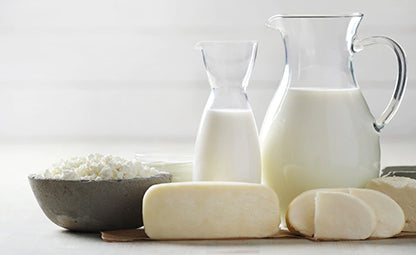Welcome to a world where pizza, ice cream, and cheese plates are no longer your friends. That's right! We're talking about food intolerance- the ultimate betrayal of the taste buds. From the occasional bloating to the dreaded stomach cramps, food intolerance can turn your once beloved meals into a nightmare. But what exactly is food intolerance, and how can you identify it? Buckle up, foodies, because we're diving into this digestive dilemma to uncover the truth behind the discomfort.
Food intolerances are somewhat prevalent. They might have an impact on 15% to 20% of the population, according to specific estimations.
An individual with a food intolerance has trouble digesting specific foods. A food intolerance differs from a food allergy, which is vital to remember.
Those with digestive system diseases, such as irritable bowel syndrome (IBS), are more likely to have food intolerances. According to the IBS network, the majority of people suffering from IBS have dietary intolerances.
Symptoms
A person who suffers from food intolerance will frequently feel uncomfortable shortly after consuming particular meals. These symptoms vary and are usually related to the digestive system.
Food intolerance symptoms commonly include:
- Headaches
- Diarrhoea
- Bloating
- Runny Nose
- Excess of gas
- Migraine
- Malaise (general sense of discomfort)
The amount of food consumed by individuals with food intolerance influences the intensity of their symptoms.
Food intolerance symptoms can take time to appear. The symptoms may appear in a few minutes or several hours after consuming a portion of food and may last for multiple hours or days.
Because the symptoms of food allergies and intolerances might be similar, it can be challenging to distinguish the differences between the two.

Types and Causes
Food intolerances develop when the body experiences trouble breaking down a particular food. This dysfunction could be brought on by a deficiency in digestive enzymes or a sensitivity to specific chemicals.
The following foods frequently linked to food intolerance are:
- Milk or dairy (lactose)
- Food preservatives and colourings
- Gluten (wheat, rye, barley, oats)
- Sulfites
- Additional compounds, including sugar and caffeine
What exactly is lactose intolerance?
We'll look at India's prevalence of lactose intolerance today. Lactose is a carbohydrate or sugar present in milk and dairy products.
The inability of the body to digest lactose is known as lactose intolerance (also referred to as milk or dairy intolerance).
The process of digesting lactose is typically carried out by the lactase enzyme, produced in the small intestine. Low lactase levels in the human body are what induce lactose intolerance.
What triggers lactose intolerance?
The MCM6 gene, which a person can inherit from their parents, is linked to lactose intolerance. The regular synthesis and operation of lactase can be disrupted by specific variations or mutations in this gene, leading to lactose intolerance.
It's a widely held belief that Indians can easily tolerate lactose. This myth stems from the fact that dairy products are a staple of our daily diets.
In India, all age groups regularly consume milk, curd, cheese, butter, and cream-based dishes. In addition, the cow is a religious figure in India. Moreover, India is the world's largest consumer and producer of milk.
According to a survey, India consumed an astounding 77.7 million metric tonnes of cow milk in liquid, ranking first globally.
Lactase insufficiency is one of the leading causes of lactose intolerance.

Different types of lactase deficiency
Primary Lactase Deficiency
It is brought on by a genetic flaw that a person inherits from their parents and family.
This sort of lactase insufficiency occurs when the body's lactase production diminishes as a result of consuming fewer dairy products in their regular diet.
Secondary Lactase Deficiency
The small intestine of the affected individual has low lactase level, which leads to this kind of lactase insufficiency.
Numerous factors, including stomach and intestine infections, digestive system lining inflammation, prolonged use of antibiotics, cancer treatment, etc., can cause this insufficiency to arise in the body.
This deficiency type is often transient, but if the underlying cause is a chronic illness, it may become permanent.
Congenital Lactase Deficiency
This unusual form of deficiency is observed in newborns. The illness is relatively rare because it only happens when both parents have faulty genes that are handed down to the child.
Lactase production is reduced to zero or near zero due to this condition, thus leading to lactose intolerance.
Developmental Lactase Deficiency
This type of insufficiency is caused by improper small intestine development at birth. It is generally transitory and becomes better with age.
How does lactose intolerance go undetected in India?
Indians take pride in their ability to tolerate lactose, whereas a significant section of the world's population cannot. It is imperative to debunk this misconception.
The truth is that limited research has been conducted in India to learn more about lactose intolerance problems. According to a recent study, approximately 60-65% of Indians are lactose intolerant. Yes! You heard it right.
Even though everyone in India consumes dairy, only 18% of people can actually digest lactose entirely. It's intriguing because a large number of the Indian population have consumed dairy products their entire lives without experiencing any symptoms of lactose intolerance.
It is because, despite being lactose intolerant, the symptoms prevalent among the Indian population are less severe than those detected in the American or European people. Therefore, most individuals overlook the idea that they are lactose intolerant.
The following are some of the most prevalent symptoms of lactose intolerance:
- Constipation
- Diarrhoea
- Bloating
- Cramps in the abdomen
- Nausea and occasional vomiting
How to Treat Lactose Intolerance
Cutting off dairy products is one of the most effective strategies to combat lactose intolerance. Dairy products are integral to many Indian consumables like tea, coffee and other beverages. Therefore, it can be challenging for people to avoid it.
The finest dairy substitute is plant-based milk. It is highly nutritious and good for health and is the first choice of health-conscious individuals because of its nutritional properties. Numerous plant-based milk, including almond, oat, soy and oat milk, are widely available. Many vegans and lactose-intolerant people have incorporated plant-based dairy into their diets.
People should be on the lookout for hidden lactose in addition to dairy. The market is flooded with foods that include lactose in the form of baked goods, sweets, and chocolates. To avoid mistakenly consuming lactose, you might choose lactose-free foods or snacks.
You should also add other sources of calcium in your diet if you avoid consuming milk. Seasonal, leafy greens, nuts and seeds, beans and lentils can fulfill the body’s calcium requirement.
Bottomline
Yet, due to a lack of information, at least 60% of the population is unknowingly harming their bodies regularly.
It is pretty surprising to learn that our culture's predominance of a Lacto-vegetarian diet has contributed to our misconception.
Many people in India are unaware that they have this condition, as the symptoms can be mild and often mistaken for other digestive issues. However, if left undiagnosed and untreated, lactose intolerance can lead to various health problems. Individuals need to be aware of this condition and seek medical advice if they suspect they may be lactose intolerant.






